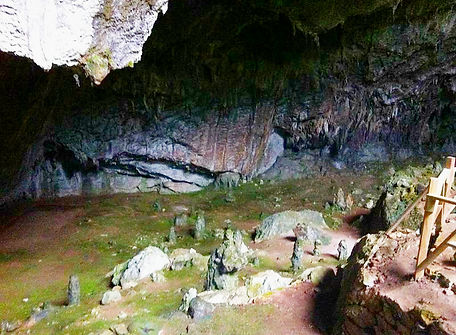NIMARA CAVE
Updated on: 13rd Sept, 2017

Paradise (Cennet) Island is not really a real island in terms of geography. Because, it has a very small connection with the mainland. So normally, there is not a strait between the island and the land. That is why the name of the place where two pieces of land are merged is called “Yalancı Boğaz (Fake Strait)". Long time ago, some ships agrounded here in darkness, trying to pass between the island and the land. A kind-hearted man tried to prevent this situation by lighting a lantern in order to warn them. He is known as “Fenerci Baba (Lantern Father)”. His tomb still warns the ships in Yalancı Boğaz. (3rd photo in the gallery)
There is a marina on the right side of Yalancı Boğaz, and on the left side there is open sea. After passing through Yalancı Boğaz, follow the direction signs for 2 km until you see a final red sign saying "Nimara Cave 400 m". (the asphalt paved road ends and gravel road begins. But it's still OK if you drive slowly. (This part of the route was a terrible road until this year. After the construction in 2017, it is in much better condition) Park your car at the side of the road and walk the rest of the trail (4th photo in gallery). It is possible to see traces and remains of donkeys and boars on the ground, but there is nothing to worry about. After walking along this trail, follow the patio and wooden stairs on the right side and finally you reach the cave, which was opened to public in 2008. There you see a wide opening into the cliffs, consisting of hundreds of stalactites and stalagmites, some of which are 2.5-3 meters tall. And you smell a slight mildew odor.
Examining the remnants in the cave, it is estimated that the people used this place about 12,000 years ago. This information refutes the argument of the famous historian Heredotus who claimed that "the history of Marmaris was based on 3000 BC". About 1500 pieces of colored glass, cutlery and sharp objects made of stone and bone were found in the limestone layer of the cave. Based upon these findings, it is inferred that the cave dates back to Bronze Age, and was used as a bead workshop, where people produced stuff with sharp objects. The shapes and features of these tools reveal that, in 10,000 BC people actually were living in the cave. There are two stone terraces inside, most probably used as a temple and a votive place. Beside the 12,000 year-old tools, hundreds of pottery pieces, urns with human figures on, numerous coins, and ceramics (dating back from 4th to 1st century BC) were found in the cave, which reveal that, people had also lived in the cave during the Roman period.
Nimara Cave is an interesting place, so is the Paradise Island. It is natural habitat for wild animals. The terrain is covered with pine and incense trees, majorams, and scrubs. Most of the regions in the island are not accessible by car, which make them preserve their naturality. There are also untouched shores and scuba diving spots around the island, such as Phosphorus Cave and Aquarium Cove. These locations are also not accessible from land. But you can visit these spots with daily boat or diving tours.
Bonus: Turn right from the sign "Nimara Cave 400 m" and walk about 200 meters. You'll see an observation terrace overlooking Bedir Island. Do not miss this spectacular view. (See the last photo in the gallery)
 |  |  |  |
|---|---|---|---|
 |  |  |  |
 |  |  |  |
 |  |  |  |
